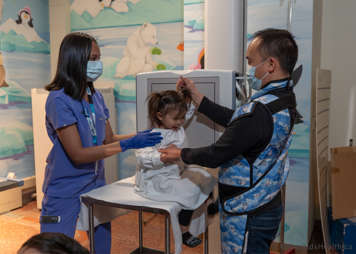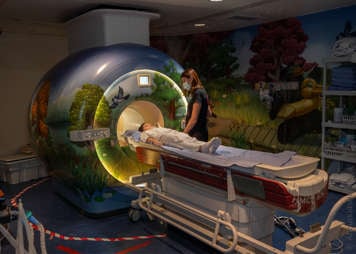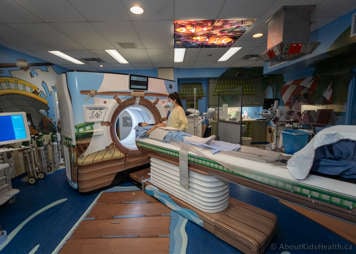Imaging tests are ways of taking pictures of the inside of the body. Different types of imaging are useful in different situations.
X-rays

What is an X-ray?
X-ray tests use high-energy rays called X-rays to take a picture of the inside of the body. The X-rays pass through the body, and a computer records and stores the picture. The picture is then sent to the health-care team to view and interpret on a computer screen.
X-ray pictures give health-care providers information on the size, shape, and location of different parts of the body:
- solid parts of the body, such as bones, appear white on the scan.
- muscle, fat and fluids appear grey on the scan.
- parts of the body that are very thin or have air in them, such as the lungs, appear black on the scan.
X-rays are used often to help make a diagnosis and are considered safe.
How is an X-ray done?
Your child, wearing a hospital gown, will be asked to stand or sit next to the X-ray board or lie on a table. Younger children may need to be restrained, while older children will be asked to hold still for two or three seconds, so the picture does not blur.
The X-ray machine will be turned on for a fraction of a second. Beams of X-rays pass through your child’s body to take a picture. Usually, an X-ray is taken from the front and then the side. X-rays are digital and your child’s health-care provider will view them directly on a computer screen.
Will the X-ray hurt my child?
Your child will not feel anything. There is very little radiation released through the X-ray, so it will not cause damage to the body. Visit the SickKids X-ray page for more information, including a video your child can watch to better understand what to expect on the day of their test.
Magnetic resonance imaging (MRI)

What is MRI?
Magnetic resonance imaging (MRI) is a way of taking pictures of the head and body without the use of X-rays. A magnet, radio signals, and a computer are used to create the pictures. An MRI scan is noisy, but it does not hurt.
Some MRI scans provide more information when they are done with a liquid called contrast. This clear, colourless fluid is put into the vein in the wrist or arm with a small tube and needle through an intravenous line (IV). If needed, the IV will be inserted before the MRI scan.
Contrast is normally very safe, but it may produce a reaction in very rare cases. The team will watch your child very closely during and after the MRI to see if your child has a reaction.
How long does an MRI take?
A number of short scans make up a complete MRI study. Each scan takes from one to 10 minutes. The total time for a complete MRI study depends on the area of the body that is being scanned, but it may take up to one to two hours.
Tell the MRI team about any metal in your child's body
Because MRI involves a strong magnetic field, certain metal implants could injure your child. Tell the MRI team if your child has had any surgeries, procedures, implants, or injuries that involved metal, such as metal rods, plates, screws, braces, clips, or body piercings.
Your child will have to empty their pockets completely of everything, including coins, keys, pens, cell phones, wallets, and bank cards. They will also have to take off their watch. Your child cannot wear any makeup or jewellery.
If your child does have any implants, please give the MRI team information about the type of device and the manufacturer. In some cases, your child may need an X-ray to confirm that it is safe for them to have an MRI.
Is there any preparation for MRI?
If your child is able to lie perfectly still for an hour, then no special preparation is usually needed for the scans. However, many children need medicine to help them sleep, so they will lie still for the scan. This medicine may be a type of sedation or a general anesthetic. The type of sedation or anesthetic your child needs depends on their age and medical condition.
Before having any sedation or general anesthetic, your child will need to have an empty stomach. The treatment team will tell you when your child needs to stop eating and drinking before the MRI.
What should I tell my child?
Tell your child exactly what will happen during the MRI scan. Explain what they will see, hear and feel. Remember, MRI scans do not hurt. Visit the SickKids MRI page for more information, including videos your child can watch to better understand what to expect on the day of their scan.
Who performs an MRI?
Several people may be involved in the procedure: a technologist, a nurse, a radiologist and—if necessary—an anesthesiologist.
- A medical radiation technologist (MRT) will do the MRI scans.
- A nurse will prepare your child for the scans. If your child is having sedation, the nurse will give the sedation. If your child is having a general anesthetic, the nurse will assist the anesthesiologist.
- A radiologist will check and interpret each MRI scan to make sure that the study is complete.
- The anesthesiologist is the health-care provider who gives the general anesthetic.
What happens during the MRI?
Your child will change into a hospital gown and lie on a bed. The technologist will place them in the correct position for the MRI scan. The MRI scanner is a large machine with a wide tunnel in the centre.
When everything is ready, the bed will be moved into the tunnel. Most of your child's body will be inside the tunnel.
Your child must lie completely still for the whole time of each MRI scan.
The MRI machine will scan your child’s body in "slices” to produce cross-sectional images. Each image shows a different slice or level of the body part being imaged. The scanner makes a loud knocking or drumming sound during scanning. Everyone staying in the room will wear ear plugs or headphones to protect their hearing.
The technologist will talk to your child through a speaker. When the MRI scan is complete, the technologist will help your child off the table.
If your child does not need to be asleep during the study, you will be able to stay in the room with your child if you wish. If you wish to stay in the room, you will also need to be screened for metal implants.
What happens after the MRI?
If your child has had sedation or general anesthetic, you must stay until they are awake. The MRI nurse will let you know when you can leave. The radiologist will review the MRI study, and a report will be sent to your child’s health-care provider. Their health-care provider will discuss the results of the study with you at a follow-up appointment.
Computerized tomography (CT)

What is a CT scan?
A computerized tomography (CT) scan uses multiple X-rays to take cross-sectional pictures of the body. These pictures allow health-care providers to see the structures inside the body at different levels. A CT scan can be done on any body part. The CT machine scans the body in "slices” to produce pictures or images. Each image shows a different slice of the body part being imaged.
Some CT scans provide more information when they are done with contrast, which is given through an IV line inserted into a vein in the wrist or arm. If the health-care team determines that your child’s CT scan would be better with contrast, it may be given partway through the study.
A child who is having an abdominal CT scan will probably be asked to drink some juice or water with X-ray contrast mixed into it. This helps make the stomach and intestines easier to see on the pictures. If your child has a favourite drink, you may bring it with you to mix with the fluid.
How long does a CT scan take?
The length of your child’s CT scan depends on many things. A routine scan may take anywhere from five to 30 minutes, depending on the part of the body being scanned, the size of your child and how still your child can lie without moving.
Is there any preparation for a CT scan?
If your child is able to lie completely still for up to an hour, they will not usually need any special preparation for a CT scan. However, some children need sedation or a general anesthetic to help them lie still for the scans.
The type of sedation your child needs depends on their age and medical condition.
Before having any sedation or general anesthetic, your child will have to be careful about what they eat or drink. The treatment team will tell you when your child needs to stop eating and drinking before the CT scan.
What should I tell my child?
Tell your child exactly what will happen during the CT scan. Explain what they will see, hear and feel. Remember, CT scans do not hurt. Visit the SickKids CT page for more information.
Who performs a CT scan?
The CT scan will be done by a team of people. A medical radiation technologist will take the pictures of your child. A nurse may be available to help your child throughout the scan and will give them sedation if needed. A radiologist will check and interpret your child’s scan before you leave to make sure it is complete. Children who require a general anesthetic will receive it from an anesthesiologist.
What happens during the CT scan?
One parent may stay in the room with the child during the scan. You will be given a lead coat to wear. When you enter the room, you will see a table and a large white donut-shaped machine with a hole in the middle. This is the camera. The camera makes some noise when it takes a picture, but it will not touch your child.
Your child will lie on a narrow bed. The technologist will make sure that your child is lying on the table in the correct position for the CT scan. Your child will be held with a safety strap. If your child is having a CT scan of the head, the technologist may place little pillows beside your child’s ears and a headband over their forehead to keep the head still.
The bed moves up and into the CT machine, which looks like a big donut. The camera moves around inside the machine and takes many pictures. The camera makes some noise when it takes a picture, but the camera will not touch your child.
Your child needs to stay very still while the camera is taking pictures. Your child can sleep (or pretend to sleep), or you can read a story to help the time go faster.
The technologist will be able to hear, see, and speak to your child during the CT scan. When the scan is finished, the technologist or nurse will help your child off the table.
What happens after the CT scan?
If your child has had sedation, you must stay until they are awake. The nurse will let you know when you can leave.
A radiologist will review the CT scan, and a report will be sent to your child’s health-care provider. Your child’s health-care provider will discuss the results of the scan with you at a follow-up appointment.